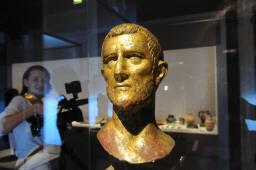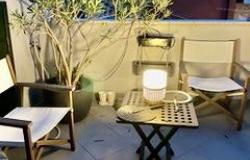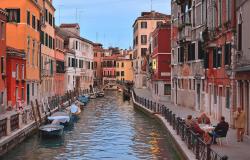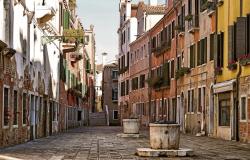Ostrogoths, Visigoths, Franks and Vandals are among the stars of a huge new exhibition in Venice showcasing the extraordinary craftsmanship of the so-called 'barbarian' cultures that reshaped the map of Europe in the first millennium AD.
In the largest exhibition of its kind ever held on the continent, around 1,700 archaeological treasures found across all corners of the western Roman Empire are on display at Palazzo Grassi, with loans from 200 collections in Europe, Africa and the USA.
'Barbarians' was how the Romans referred to the Germanic peoples who migrated through the empire from northern and eastern Europe from the fourth to eighth centuries, sacking Rome in the process and unseating the last emperor, Romulus Augustus, in 476 AD.
One of the aims of the show is to redress the bad rap given to the barbarians who took advantage of the western Roman empire's ailing economy and infighting to settle across imperial frontiers, fleeing in their turn from incursions by the Huns from the central Asian steppes.
''Contrary to the accepted image of famished, inarticulate Goths dressed in animal skins, many barbarians were Christian, refined and conversant in the use of Greek and Latin,'' Palazzo Grassi's director Monique Veaute explained.
The show kicks off with Roman treasures from when the empire still held the barbarians at bay and the cult of the emperor endured in Roman territories. Included in this section are the first-century Sarcophagus of Portonaccio from Rome, carved with a Roman defeat over a Germanic army in a tangle of bodies, horses, spears and helmets, and a second-century 22-carat gold bust of the Emperor Marcus Aurelius fished out of a sewer in Avenches, Switzerland, in 1939.
But barbarian-made objects are the main focus of the exhibition. According to curator and former French minister of culture Jean-Jacques Aillagon, many of the archaeological relics on display are ''true national treasures,'' such as the two surviving gold bees from what was once a 300-strong swarm found in the tomb of Childeric (437-481), king of the Merovingian Franks, in Tournai, Belgium. Most of the bees, along with coins and other precious objects from the tomb, were stolen from the National Library of France and melted down in 1831. Some objects are making their international debut for the show, including the exquisite Merovingian seventh-century gold cloisonne Casket of Teuderic, which has left the Abbey of Saint-Maurice in Switzerland for the first time in 1,400 years.
Among other highlights are a seventh-century votive Visigoth cross from Guarrazar in Spain; a sixth-century carving of Amalasuntha, queen of the Ostrogoths, who ruled Italy from Ravenna; and fifth-century grave treasure from the Vandal kingdom of Carthage in Tunisia.
Several priceless manuscripts from the period are also on show, including the eighth-century Celtic Book of Mulling from Ireland, the Gospels of Saint-Vaast and Marmoutier in France, and a miniature manuscript of the Gospel according to St John copied in Italy between the fifth and sixth centuries.
''Europe may have been born in Athens, Jerusalem and Rome, but many of its roots lie in the peoples of the north and east of the European continent,'' Aillagon said.
''The exhibition invites visitors to reflect on Europe's current situation as a political and cultural entity that once again finds itself learning to live with an increasing number of people from other parts of the world''.
'Rome and The Barbarians - The Birth of a New World' is at Palazzo Grassi until 20 July.














